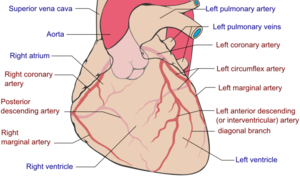Coronary Artery
Original Editor - Your name will be added here if you created the original content for this page.
Top Contributors - Lucinda hampton, Rania Nasr and Kim Jackson
Description[edit | edit source]
Coronary arteries supply blood to the myocardium. There are two primary coronary arteries, the right coronary artery (RCA) and left main coronary artery (LMCA). They originate from the root of the aorta. Their main function is to supply blood to the heart. This is a crucial function for myocardial function and subsequently homeostasis of the body[1].
Path[edit | edit source]
The coronary arteries run along the coronary sulcus of the myocardium of the heart[1].
Divisions[edit | edit source]
The RCA and LMCA extend from the aortic root to supply different regions of the heart. The RCA gives rise to the sinoatrial nodal branch of the right coronary artery, posterior descending artery branch of the RCA, and the marginal branch. While the LMCA branches into the circumflex artery (Cx) and the left anterior descending artery (LAD). The Cx gives rise to the left marginal artery and posterior descending artery (in a left-dominant heart). The left anterior descending artery gives off the diagonal branches[1].
Supply[edit | edit source]
The RCA emerges from the anterior ascending aorta and supplies blood to the right atrium, right ventricle, SA node, and AV node. It descends into smaller branches including the right posterior descending artery (PDA) and acute marginal artery. In conjunction with the left anterior descending artery (LADA), the RCA helps supply blood to the septum of the heart[1].
The LMCA gives off two major branches; the left anterior descending (LAD) and the left circumflex (LCx) coronary arteries, which supply blood to the left atrium and left ventricle. The LAD supplies blood to the front and the left side of the heart. The circumflex artery is responsible for blood supply to the left atrium and the posterior-lateral aspect of the left ventricle[1].
Clinical Relevance[edit | edit source]
Coronary artery disease (CAD, also called coronary heart disease, or CHD) is caused by the narrowing of the coronary arteries. Arteries that have become extremely narrow can cause shortness of breath and chest pain during physical activity. If a coronary artery suddenly becomes completely blocked, it can result in a Myocardial Infarct/heart attack[2].
Related pages[edit | edit source]
Physical Activity and Cardiovascular Disease
References[edit | edit source]
- ↑ 1.0 1.1 1.2 1.3 1.4 Ogobuiro I, Tuma F. Anatomy, Thorax, Heart Coronary Arteries. In: StatPearls [Internet]. Treasure Island (FL): StatPearls Publishing; 2019 Jan.
- ↑ InformedHealth.org [Internet]. Cologne, Germany: Institute for Quality and Efficiency in Health Care (IQWiG); 2006-. Coronary artery disease: Overview. 2013 Feb 13 [Updated 2017 Jul 27].
- ↑ Armando Hasudungan. Cardiology - Coronary Blood Supply. Available from: https://www.youtube.com/watch?v=3wpT-4bSmoU [last accessed 26/9/2019]







